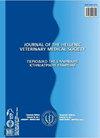工业沙拉夫提奶酪的生化和微生物特性
IF 0.4
4区 农林科学
Q4 VETERINARY SCIENCES
引用次数: 0
摘要
Tsalafouti是一种白色奶酪,有轻微的酸味。其可铺展的质地不含气体。在本工作中,对Tsalafouti奶酪进行了工业化生产,并对其生化、感官和微生物特性进行了研究。贮藏30 d时,平均pH为4.05,水分含量为68.06%,脂肪14.9%,干脂肪46.52%,盐1.55%,灰分2.4%,蛋白质10.92%。蛋白水解水平在贮藏过程中保持稳定。挥发性化合物甲基丁醇、乙醇、乙醇、丙酮在第30天含量较高。在感官评估期间,Tsalafouti非常受欢迎,直到第45天。在含脱脂牛奶的培养基上,在37℃下,从工业成熟奶酪储存的第15天至第90天,活菌总数保持在7.5-8.0 log CFU/g之间。然而,典型的中温性乳酸菌(LAB)增加到8.1-8.5 log CFU/g,并在整个储存过程中占主导地位,而典型的嗜热性LAB(包括肠球菌)在整个储存过程中仍保持1-3 log单位的次优势。在第30 ~ 45天,酵母数量在6 ~ 7 log CFU/g以下时,有利于工业沙拉提感官品质的提高;然而,随着贮藏时间的延长(60至90天),酵母的数量增加到7.5 log CFU/g后,酵母成为主要的变质剂。所有工业奶酪样品都是微生物安全的,因为它们的pH值很低(3.85至4.13)。这些数据可能有助于更好地识别传统的希腊Tsalafouti奶酪。本文章由计算机程序翻译,如有差异,请以英文原文为准。
Biochemical and microbiological characteristics of industrial Tsalafouti cheese
Tsalafouti is a white cheese with mild sour, acidic taste. Its spreadable texture has no gas holdings. In the present work, Tsalafouti cheese was industrially manufactured and its biochemical, organoleptic and microbiological characteristics were investigated. At 30 days of storage, the mean pH was 4.05 and moisture content was 68.06%, fat 14.9%, fat-in-dry matter 46.52%, salt 1.55%, ash 2.4%, and proteins 10.92%. Level of proteolysis remained stable during storage. The volatile compounds 3 methyl butanol, acetoin, ethanol, acetone, were found in high levels on day 30. During the organoleptic evaluation Tsalafouti was very much appreciated until day 45. Total viable counts enumerated on skim-milk containing media at 37oC remained constant within 7.5-8.0 log CFU/g from day 15 to day 90 of storage of the industrially ripened cheese. However, typical mesophilic lactic acid bacteria (LAB) increased to 8.1-8.5 log CFU/g and predominated the technological biota, whereas typical thermophilic LAB, inclusive of enterococci, remained subdominant by 1-3 log units throughout storage. Yeasts were beneficial for the sensory quality of industrial Tsalafouti from day 30 to 45 when their counts were below 6-7 log CFU/g; however, yeasts turned to be the primary spoilage agents after their counts increased to 7.5 log CFU/g with prolonged storage (day 60 to 90). All industrial cheese samples were microbiologically safe as due to their low pH (3.85 to 4.13). These data could be useful for the better recognition of traditional Greek Tsalafouti cheese.
求助全文
通过发布文献求助,成功后即可免费获取论文全文。
去求助
来源期刊

Journal of the Hellenic Veterinary Medical Society
VETERINARY SCIENCES-
CiteScore
0.60
自引率
0.00%
发文量
83
审稿时长
>12 weeks
期刊介绍:
The Journal of the Hellenic Veterinary Medical Society (J Hellenic Vet Med Soc) is a quarterly peer-reviewed journal that publishes articles in all aspects of veterinary science and related disciplines. It is published by the Hellenic Veterinary Medical Society and is indexed in the Web of Science and in Scopus.
There are no publication fees in the journal. Authors considering submitting manuscripts for evaluation and publication are requested to read carefully the instructions for authors and fully comply with them.
Non-complying manuscripts may be returned to the corresponding author for formatting.
 求助内容:
求助内容: 应助结果提醒方式:
应助结果提醒方式:


